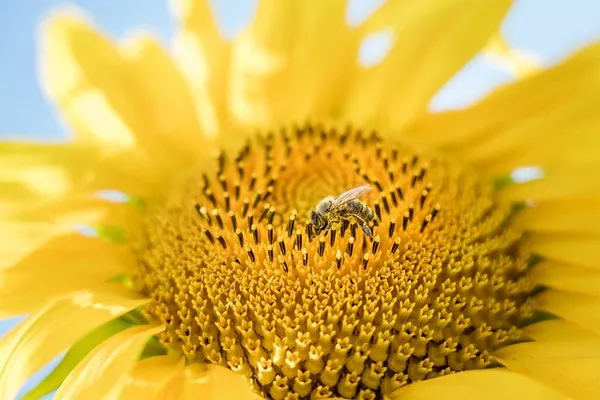Sunflowers are iconic symbols of beauty and vitality in gardens around the world. Their towering stalks and vibrant blooms bring joy to both garden enthusiasts and casual admirers. However, sunflower plants are not immune to pests that can affect their health and appearance. If you’ve noticed mysterious holes, discoloration, or wilting on your sunflower leaves, it’s crucial to identify the culprit responsible for this damage. In this article, we will explore common pests that could be feasting on your sunflower leaves and provide guidance on how to effectively manage them.
Common Sunflower Pests
Sunflower Beetles (Zygogramma exclamationis)
Sunflower beetles, scientifically known as Zygogramma exclamationis, are among the most common pests that target sunflowers. These small, leaf-feeding beetles have a distinctive appearance, with yellow-orange bodies and three black dots on their wings, resembling an exclamation mark. Sunflower beetles feed on the sunflower’s leaves, leaving behind skeletonized, tattered foliage. These pests can be particularly damaging if their populations are not controlled.
Management: To control sunflower beetles, consider using insecticides specifically formulated for these pests. You can also employ biological control methods by introducing natural predators, such as ladybugs, to keep the beetle population in check.
Aphids (Aphidoidea)
Aphids are tiny, soft-bodied insects that come in various colors, including green, yellow, and black. They are known for their rapid reproduction and ability to suck sap from plants, causing damage to sunflower leaves. When aphids infest sunflowers, they may distort the leaves, causing them to curl, yellow, or become misshapen.
Management: You can manage aphids by using insecticidal soaps or neem oil, which effectively disrupt their feeding habits. Encouraging natural predators, such as lacewings and ladybugs, to thrive in your garden is another way to control aphid populations.
Grasshoppers (Orthoptera)
Grasshoppers are well-known for their voracious appetite and ability to consume large amounts of plant material in a short period. These insects chew through sunflower leaves, creating irregular holes and severe damage. Their presence can be particularly problematic during warm, dry seasons when grasshopper populations tend to surge.
Management: You can protect your sunflowers from grasshoppers by using physical barriers, such as row covers or mesh netting, to prevent these pests from accessing your plants. Alternatively, consider introducing natural predators, such as birds or praying mantises, to help keep grasshopper numbers under control.
Cutworms (Noctuidae)
Cutworms are the larvae of various moth species, and they are notorious for feeding on the base of sunflower stems and leaves. They are often active during the night, which makes them challenging to detect during the day. Cutworms chew through the stem at the base of the sunflower, causing the plant to wilt and sometimes die.
Management: To protect your sunflowers from cutworms, create physical barriers by placing cardboard collars or toilet paper rolls around the base of the plants. These barriers will prevent cutworms from reaching the sunflower stems. Additionally, you can use biological control methods by introducing beneficial nematodes, which are natural predators of cutworms.
Sunflower Moths (Homoeosoma electellum)
Sunflower moths, specifically the Homoeosoma electellum species, are tiny, brownish-gray insects that lay their eggs on sunflower leaves. The larvae that emerge from these eggs feed on the leaves, creating a characteristic “windowpane effect.” These moths can cause significant aesthetic damage to your sunflower plants.
Management: To control sunflower moths, consider using chemical insecticides that are effective against moth larvae. Regularly inspect your plants for eggs and larvae, and remove them by hand when detected. In some cases, introducing parasitoid wasps can also help control sunflower moth populations.
Slugs and Snails (Gastropoda)
Slugs and snails are mollusks that feed on sunflower leaves, leaving behind irregular holes and a slimy trail. They are most active during the night and thrive in damp, cool conditions. If you notice sunflower leaves with irregular holes and a silvery trail nearby, slugs or snails may be to blame.
Management: To control slugs and snails, implement cultural practices such as removing debris and maintaining a clean garden to reduce their hiding spots. You can also use physical barriers like copper tape or beer traps to deter these pests. Additionally, there are chemical baits available for slug and snail control.
Whiteflies (Aleyrodidae)
Whiteflies are tiny, white insects that feed on sunflower leaves by piercing them and extracting plant sap. Their feeding weakens the plant and can cause the leaves to yellow, wilt, and become sticky due to the honeydew they excrete. In some cases, whiteflies may also transmit plant diseases.
Management: To manage whiteflies, employ insecticidal soaps or neem oil to disrupt their feeding. Regularly inspect your sunflowers and remove infested leaves to reduce whitefly populations. In greenhouses, biological control methods, such as introducing parasitic wasps, can be effective in controlling whiteflies.
Cucumber Beetles (Acalymma vittata)
Cucumber beetles are small, yellowish-green beetles with black stripes that target a variety of plants, including sunflowers. They feed on sunflower leaves, causing irregular holes and damage. Additionally, cucumber beetles can transmit plant diseases, which can further harm your sunflowers.
Management: To control cucumber beetles, consider using insecticides specifically formulated for these pests. You can also employ physical barriers, like row covers, to protect your sunflowers from infestation. Crop rotation can help reduce the overwintering populations of cucumber beetles.
Conclusion
Identifying the pest responsible for eating your sunflower leaves is the first step towards effective management. While there are various common pests that may affect your sunflowers, there are also multiple strategies you can employ to protect your plants. Whether you choose chemical, biological, or cultural control methods, the key is to regularly inspect your sunflowers, be proactive in managing pest populations, and maintain a healthy garden environment to keep your sunflowers thriving and vibrant. By taking action to protect your sunflowers from pests, you can ensure that these beautiful plants continue to bring joy to your garden for years to come.


